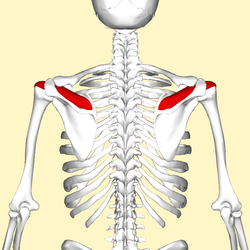 Action of right supraspinatus muscle, anterior view. Three bones shown are acromion (top) and coracoid process (center) of scapula, and humerus (left).  | |||||
| Position of the supraspinatus muscle (red) seen from the back. | |||||
| Posterior view of muscles connecting the upper extremity to the vertebral column. Supraspinatus muscle is labeled in red at right, while it is covered by other muscles at left. | |||||
| Latin | musculus supraspinatus | ||||
| Gray's | subject #123 440 | ||||
| Origin | supraspinous fossa of scapula | ||||
| Insertion | superior facet of greater tubercle of humerus | ||||
| Artery | suprascapular artery | ||||
| Nerve | suprascapular nerve | ||||
| Actions | abduction of arm and stabilizes humerus see part on controversy of action. | ||||
The supraspinatus (plural supraspinati, from Latin supraspinatus) is a relatively small muscle of the upper arm that runs from the supraspinatous fossa superior of the scapula (shoulder blade) to the greater tubercle of the humerus. It is one of the four rotator cuff muscles and also abducts the arm at the shoulder. The spine of the scapula separates the supraspinatus muscle from the infraspinatus muscle, which originates below the spine.
Contents |
Origin
The supraspinatus muscle arises from the supraspinous fossa, a shallow depression in the body of the scapular above its spine. The supraspinatus muscle tendon passes laterally beneath the cover of the acromion. Research in 1996 showed that the postero-lateral origin was more lateral than classically described.[1]Insertion
The supraspinatus tendon is inserted into the most superior facet of the greater tubercle of the humerus.The distal attachments of the three rotator cuff muscles that insert into the greater tubercle of the humerus can be abbreviated as SIT when viewed from superior to inferior (supraspinatus, infraspinatus, and teres minor).
The acronym SITS regarding the rotator cuff muscles is completed by including the subscapularis muscle, which unlike the other rotator cuff muscles attaches to the lesser tubercle of the humerus.[2]
Innervation
The supraspinatus muscle is supplied by the suprascapular nerve (C5 and C6), which arises from the superior trunk of the brachial plexus and passes laterally through the posterior triangle of the neck and through the scapular notch on the superior border of the scapula. After supplying fibers to the supraspinatus muscle, it supplies articular branches to the capsule of the shoulder joint.This nerve can be damaged along its course in fractures of the overlying clavicle, which can reduce the person’s ability to initiate the abduction.
Action
Contraction of the supraspinatus muscle leads to abduction of the arm at the shoulder joint. It is the main agonist muscle for this movement during the first 10-15 degrees of its arc. Beyond 30 degrees the deltoid muscle becomes increasingly more effective at abducting the arm and becomes the main propagator of this action.The supraspinatus muscle is one of the musculotendinous support structures called the rotator cuff that surround and enclose the shoulder. It helps to resist the inferior gravitational forces placed across the shoulder joint due to the downward pull from the weight of the upper limb.
The supraspinatus also helps to stabilize the shoulder joint by keeping the head of the humerus firmly pressed medially against the glenoid fossa of the scapula.
For USMLE step 1, know that the supraspinatus initiates abduction of the shoulder. Without a functioning supraspinatus, the physician must start abducting the patient's arm and eventually the patient will be able to finish abduction if the deltoid is functional, which is common because the supraspinatus is innervated by the suprascapular nerve from the superior/upper trunk of the brachial plexus. The deltoid is innervated more distally by the axillary nerve, which arises from the posterior cord of the brachial plexus.

